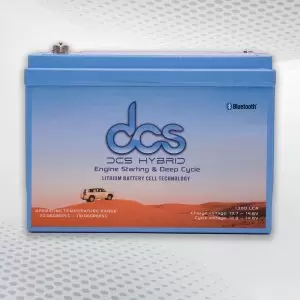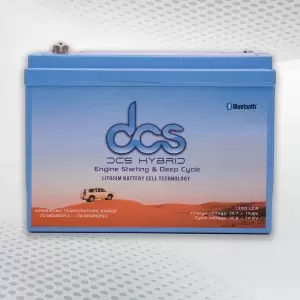Get ready to rev up your engines and dive into the world of sustainable mobility with us! In recent years, there has been a significant shift towards environmentally-friendly transportation options, and one of the key players in this evolution is the lithium car battery. These powerful energy storage devices have driven innovation and paved the way for a greener future. But how exactly did we get here? What challenges have we faced? And what does the future hold for lithium batteries? So buckle up and join us on this exciting journey!
The Origins Of Lithium-Car Batteries: A Retrospective Look At Sustainable Innovation
During this era, the world first glimpsed the potential of electric vehicles as a greener, more sustainable means of transportation. But these early electric models were powered by rudimentary lead-acid batteries that lacked efficiency, longevity, and power. Enter lithium, a lightweight, energy-dense metal with the potential to revolutionize battery technology. This opened the door for lithium ions to be inserted into the battery’s electrodes, creating a rechargeable battery with remarkable energy density.
However, the path to commercial success wasn’t smooth. Early lithium batteries were plagued with safety issues and instability. Over the years, continued research and development have seen the lithium battery evolve into the efficient, powerful, and durable energy storage solution. Lithium has become a mainstay of not only electric vehicles but also portable electronics, revolutionizing our daily lives in the process.
Revolutionizing Electric Car Technology With Lithium Batteries
The heart of the electric vehicle revolution beats the rhythm of lithium car batteries. This revolutionary power source has been instrumental in propelling the shift from combustion engines to electric drivetrains, marking a milestone in our quest for sustainable transportation. But what makes lithium batteries so transformative? For starters, they pack a powerful punch. Thanks to their high energy density, lithium batteries can store substantial energy in a compact space, ensuring electric vehicles are efficient but also practical and roadworthy. These batteries have turned the range anxieties of yesteryears into road-trip possibilities, making long-distance electric travel a reality. Then, there’s the matter of power.
Lithium batteries can discharge and recharge rapidly, translating to speedy acceleration and quick charging times. They offer electric vehicles the performance and convenience that rivals, if not surpass, their gasoline counterparts. However, the lithium battery’s influence extends beyond the confines of the vehicle. It’s fostering an energy ecosystem where renewable energy can be stored and used when needed. Think of solar-powered homes where excess energy charges an electric vehicle or a grid powered by wind and sun with battery storage smoothing out the supply.
How Lithium Battery Is Driving The Electric Car Revolution
The lithium car battery is not just participating in the electric car revolution; it’s firmly in the driver’s seat, steering the course of this transformative movement. As the powerhouse of electric vehicles (EVs), these batteries offer a compelling alternative to the fossil-fuel-dependent engines of the past. Their high energy density delivers exceptional driving range, a critical factor influencing the uptake of EVs. Using lithium as the core component, electric vehicle technology has matured significantly, paving the way for highly efficient and durable vehicles.
This innovation allows cars to cover impressive distances of hundreds of miles on a single battery charge, considerably reducing the need for frequent recharging and effectively allaying ‘range anxiety.’ Thanks to lithium batteries, this impressive feat is a futuristic vision and a current reality. They have also made regenerative braking – a feature that harnesses and converts kinetic energy into electricity – achievable, thereby amplifying energy efficiency. Therefore, lithium batteries are not merely powering EVs; they are reconstructing our perceptions of sustainable mobility and demonstrating what is attainable, guiding us towards an increasingly electric-dominated future on the roads.
Current Challenges And Solutions In 12v Lithium Batteries Technology
Lithium batteries are leading the way as we strive towards a future powered by electric vehicles. However, like all trailblazers, they, too, face their share of hurdles. For one, 12v lithium batteries tend to degrade over time, curtailing their efficiency and lifespan. Additionally, they pose potential fire risks, which often sparks apprehension. But fear not; our scientists and engineers are on the case. They are exploring solutions like incorporating nanomaterials and solid-state electrolytes into lithium battery technology.
The aim? To bolster battery life and safety. Emerging modifications like incorporating nanomaterials and solid-state electrolytes promise to revolutionize lithium battery technology by significantly enhancing their performance and reliability. Confronting these technical challenges is a testament to human ingenuity and our unyielding pursuit of sustainable alternatives. The path to perfecting lithium batteries is riddled with difficulties, yet it’s a voyage we are devoted to completing. This commitment is driven by the crucial role these batteries play in shaping a sustainable future of mobility, thereby justifying every effort to resolve the existing challenges.
Lithium-Car Battery Recycling: An Essential Component Of Sustainable Mobility
When the curtain falls on a lithium-car battery’s life, it’s not the final act. The encore performance begins with recycling – an essential component of sustainable mobility. Recycling allows us to turn the spotlight back on valuable materials like cobalt and nickel. Extracting these materials from spent batteries can breathe new life into them, offsetting the need for fresh mining and reinforcing the cycle of sustainability. And the green room behind the scenes? It’s bustling with companies investing in advanced recycling technologies.
These backstage heroes are scripting a narrative that echoes the broader ethos of the electric vehicle industry – sustainability at every stage. The script is still being written, but one thing is clear – the journey of a lithium-car battery doesn’t end at ‘retirement’; it’s merely a transition to a new, eco-friendly chapter. It’s a round of applause for our commitment to sustaining a greener future. So, next time you look at your electric car, remember that its lithium battery isn’t just a power source – it’s a testament to our endless pursuit of sustainability, even beyond its active life.
 Exploring Alternative Battery Materials For Future Sustainable Mobility
Exploring Alternative Battery Materials For Future Sustainable Mobility
As we navigate the route to sustainable mobility, it’s clear that lithium is our trusty compass. But it’s also crucial to scout out other potential paths. After all, diversifying our toolkit can only strengthen our pursuit of a greener tomorrow. So, what’s beyond lithium? It’s an eclectic mix of sodium, magnesium, and aluminium. These alternatives to lithium could potentially unlock even higher energy densities and provide a more plentiful resource base. This means our electric vehicles could go the extra mile (literally!), bolstering both sustainability and efficiency. The research is still exploratory, but the potential is electrifying.
Can you imagine a day when diverse and efficient battery materials power our electric vehicles? It’s a possibility that’s worth the research. As we delve into these promising alternatives, the blueprint for future sustainable mobility is gradually coming into focus. So, while lithium continues to play the starring role, let’s not forget the potential supporting cast, ready to contribute to the sustainable mobility revolution. The future of battery technology isn’t written in stone, or lithium, for that matter. There’s a world of possibilities out there waiting to be explored.
Maximizing Efficiency: Strategies For Improving 12v Lithium Ion Batteries
Navigating the course of a greener future demands not only innovation but also constant improvement. And that’s precisely the goal of 12v lithium ion batteries – maximizing efficiency and performance. But how exactly are we pulling this off? For starters, we’re focusing on enhancing the design of these batteries. By refining the battery cell’s architecture, we can improve energy distribution and thermal management. This optimizes the battery’s performance and mitigates the risk of overheating, a common concern with lithium-ion batteries.
Additionally, researchers are exploring the use of innovative materials in battery construction. From advanced cathode materials to improved electrolytes, these modifications aim to increase the energy density of the batteries, translating to a longer driving range and fewer charging stops.
We’re also delving into the realm of software enhancements. Smart charging algorithms and battery management systems are being developed to extend battery life and optimize charging processes, effectively squeezing more miles out of each charge.
The Environmental Impact Of Lithium Battery Production And Disposal
Lithium batteries, while revolutionary for sustainable mobility, do come with an environmental toll. It starts at the very beginning with lithium mining, a process that can be quite invasive. Expansive lithium mines may cause landscape degradation and habitat destruction. Not to mention, the extraction process requires a substantial amount of water, potentially leading to water scarcity issues in dry, arid regions where lithium reserves are often found. Further, along the lifecycle, the production process of lithium batteries also demands a significant amount of energy.
This energy often stems from fossil fuels; thus, the production phase inadvertently contributes to greenhouse gas emissions. The environmental impact doesn’t end there. Once a lithium battery has reached the end of its life, improper disposal can pose serious environmental hazards. When discarded in landfills, the heavy metals within lithium batteries can leach into the soil and groundwater, posing risks to the environment and public health. But, as daunting as these environmental challenges may seem, they’re not insurmountable. We can mitigate these impacts with improved mining practices, cleaner production methods, and robust recycling programs.
FAQs
Q: Are Lithium Batteries Safe?
A: While safety concerns have been related to fire risks, technological advances and improved safety measures have made lithium batteries considerably safer. Rest assured, engineers are continually working to enhance their safety further.
Q: How Long Does A Lithium Car Battery Last?
A: Lithium car batteries typically last up to 10 years or even longer. Factors like usage, temperature, and charging habits greatly influence their lifespan.
Q: Can Lithium Car Batteries Be Recycled?
A: Absolutely! Recycling lithium batteries is not just possible but also a vital part of the sustainable mobility movement. The process helps recover valuable materials like cobalt and nickel, reducing the need for fresh mining.
Q: How Can The Efficiency Of A Lithium Battery Be Improved?
A: Engineers are continually innovating to enhance lithium battery efficiency. Strategies include refining battery design, exploring new materials, and using smart charging algorithms and battery management systems.
Q: What Are The Environmental Impacts Of Lithium Battery Production?
A: Mining lithium, necessary for these batteries, can lead to potential water and soil pollution. Additionally, improper disposal of old batteries can impact the environment. That’s why employing cleaner production techniques and robust recycling programs is critical.
Q: Are There Alternatives To Lithium Battery Technology?
A: Yes, research is underway to explore alternatives like sodium, magnesium, and aluminium. These could offer higher energy densities and a more plentiful resource base.
Conclusion
As we cruise down this electrifying path of sustainable mobility, Lithium Car Battery has undoubtedly emerged as the reliable co-pilots in our journey. From their humble beginnings in the 70s to their star role in today’s electric vehicle revolution, they’ve powered progress and fostered innovation at every turn. Yet, we recognize that this is just the starting line. With emerging alternatives like sodium, magnesium, and aluminium, the race to maximize efficiency, longevity, and safety in battery technology is underway.
| Other Good Articles to Read |
| Blogs-Nation |
| Blogs-Peoples |
| Bryan Smith Blogs |
| intellect blogs |
| the fault in our blogs |
| blogs eu |
| oz forums |
| Recruitment Blogs |
| Zet Blogs |
| Id Blogs |
| Blogs Tudiolegale |
| Blogs Map |
| Related Business Listings |
| Contact Directory |
| Local Business Profiles |



